Making space for teens in museums can sometimes be met with apprehension. Is our program engaging enough? Will they be interested? Can we handle their potential criticisms? These are all honest questions that spring to the minds of even the savviest museum worker. Considering the Chicago History Museum’s mission, including teens became a priority.
To create our teen engagement framework, the education team turned to the experts—colleagues at teen-serving museums and teens themselves to explore best practices to prime our teen engagements for success. A set of criteria emerged:
- Meet the teens where they are (culturally, emotionally, academically, and socially)
- Recruit teens with similar interests (history, art, civic engagement, sports)
- Provide a balance of content engagement (in our case history) and creative expression
- Position teens as key contributors with decision making power
- Make connections between exhibition content and the teens’ lived experiences
- Allow teens to share in setting the norms for engagement and collaboration
There are also mutual benefits of teen engagement in museums. Through the programs at CHM, teens recognize the impact of history and their role in creating the future. While museums provide opportunities that help teens learn and grow, they have an opportunity to serve as entry points to arts and culture, sparking lifelong interest in museums. At CHM, teens’ inputs and feedback have helped shape subsequent teen opportunities. Past CHM teen projects have centered Chicago’s legacy of activism for universal suffrage, the power of community documentation, and identity-confirming fashion in the city.
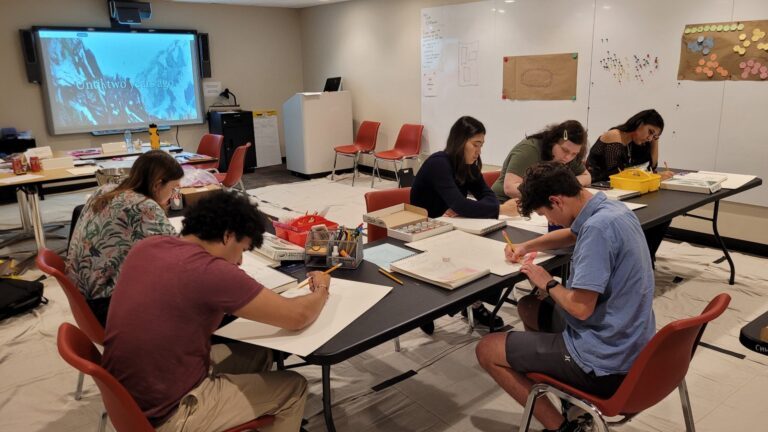
The Artivism teens creating posters in an arts-making session during their summer 2024 experience. All photographs by CHM staff.
In the summer of 2024, a group of teens with interests in social justice and art participated in an intensive experience in support of CHM’s exhibition Designing for Change: Chicago Protest Art of the 1960s–70s. The exhibition historicizes Chicago’s legacy of activist art and the unique capacity of art to catalyze change. A cohort of six Chicago-area teens created vibrant messages for issues today using art techniques of the period.
The Chicago Artivism (art + activism) Teens project met multiple needs, including paid summer employment and access to arts education, as many public schools in our area have limited arts instruction. The importance of this opportunity to local teens was confirmed by grant funding from the National Endowment for the Arts. At CHM, we value teen expression and believe in the power of activist art to catalyze change. This project offered an impactful civic platform for the teens, providing a megaphone for issues they cared about.
The selection processes helped us identify teens we felt had a willingness to learn, would bring a collaborative spirit and unique perspectives, and who represented metro Chicago’s demographics. This resulted in a group of six artivists, ready to learn and create with one another and with project staff.
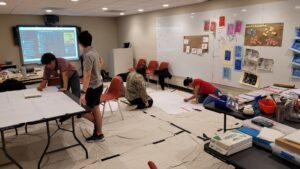
A working session with the Artivism teens in their studio space at the Museum.
The program design included eleven working sessions and a final twelfth day dedicated to a showcase of teens’ art. Initial days included orientation and community building activities that cemented cohort dynamics. Teens connected with Museum education and curatorial staff in the Designing for Change exhibition with learning activities such as:
- Discussions on visual thinking strategy
- Mini exhibition tours
- Creative writing responses
- Oral history practice interviews
- Hands-on object analyses
- Short talks
- Peer-to-peer teaching
Afternoon artmaking was facilitated by Jomo Cheatham, a local, longtime, youth-focused teaching artist. Under his tutelage the teens worked as individuals, as pairs, and as a whole group in a variety of mediums present in the exhibition, including line drawing, painting, silk screening and block printing.
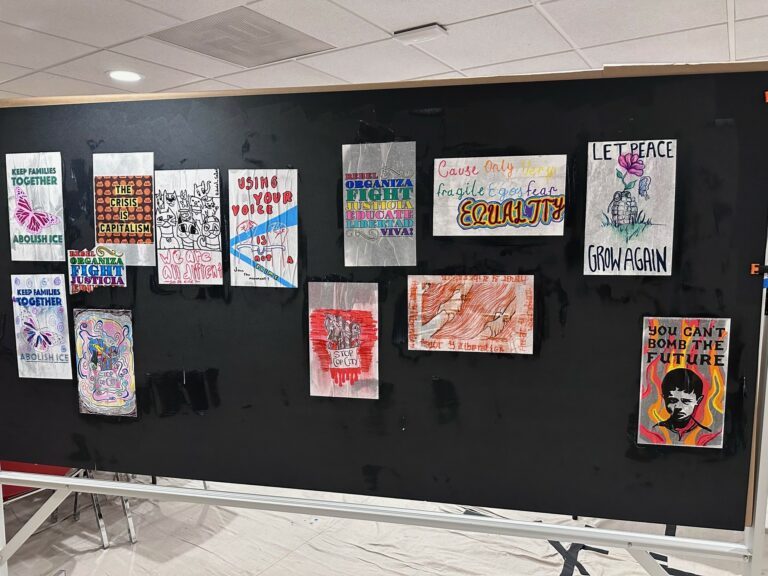
Examples of wheatpasting from the teens’ session, including prints from Justseeds Artists’ Cooperative.
Assisting our teaching artist was a near peer mentor, Audrey O’Hearn, a summer education intern who came to us through Studio Institute. She worked alongside the teens on their projects most afternoons and led one special session on the history and practice wheatpasting in protest art. This session combined the Chicago Artivism teens and Aquí en Chicago teen interns to create activist art jointly. She also collaborated with the teens to design an invitation to the showcase.
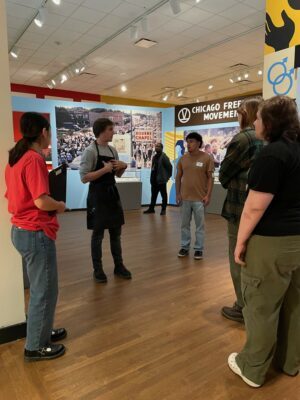
The teens tour the Designing for Change exhibition with lead exhibition preparator Ethan Gasbarro during a Career Walk and Talk session.
Teens were also introduced to a variety of museum work through a Career Walk and Talk, meeting employees who specialize in visitor services, curation, exhibition production, graphic design, security, and conservation at CHM. Reflecting on their experience during their project evaluation, one teen wrote, “. . . I was already interested in working in museums, but this gave me more knowledge on the many ways that can be done, including creative ways I had not considered.”
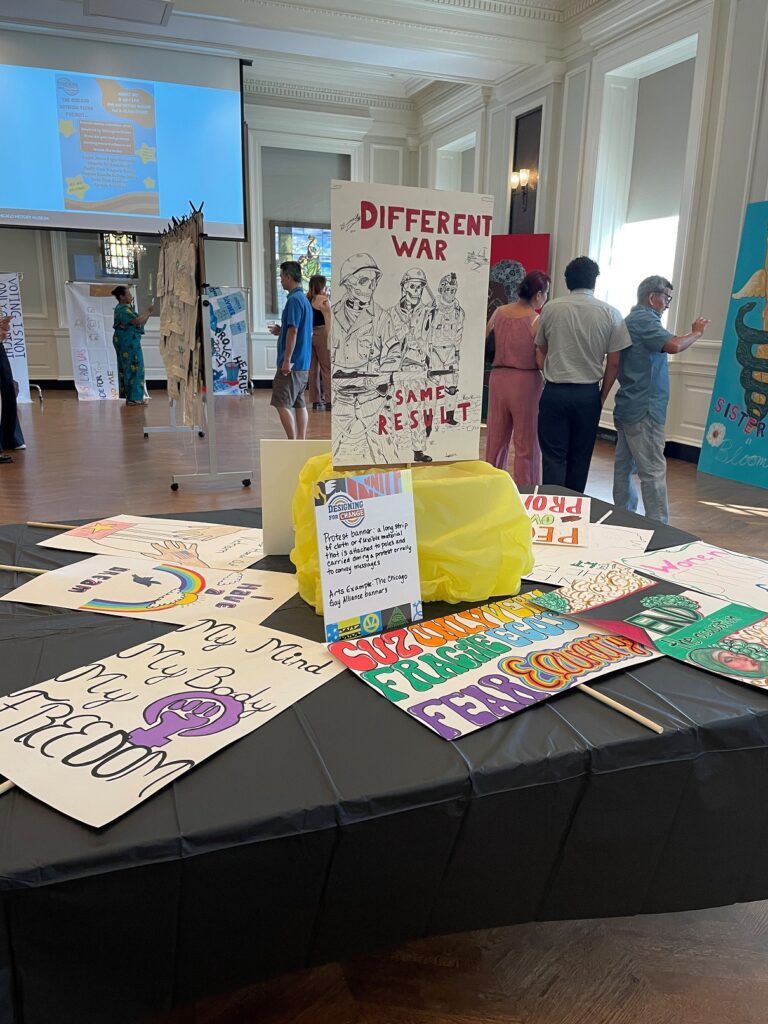
A display of protest posters in the Artivism teens’ showcase.
The internship culminated in a showcase of the teens’ work, which included protest signs, zines, block prints, protest banners, silk screened t-shirts and tote bags, all featuring causes and issues the teens were passionate about. A highlight was five large mural panels, one dedicated to each of the main sections of the Designing for Change exhibition. These murals reflected the teens’ understanding of the social movements and artistic expression of the 1960s and ’70s, while the other pieces connected that history and inspiration to contemporary life.
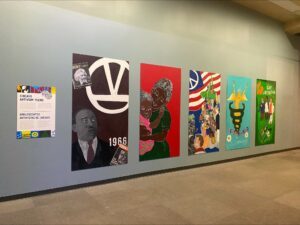
Chicago Artivism teens mural display in CHM’s Chicago: Crossroads of America exhibition.
On their evaluation one teen noted, “I am most proud of the murals we made. Since we made them during the last weeks of the internship, they represent all that we learned about the different movements. Also, my art and painting skills significantly improved, and some of my best work was on the murals. Lastly, I love that we all collaborated on the murals, so they represent our art as a collective.”
Teens wrote labels for the showcase including biographies and artist statements. They also collaborated on a manifesto describing their collective practice and intentions for their art.
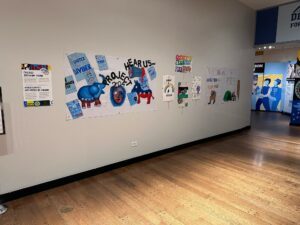
The collection of protest signs and banners on display outside of the Designing for Change exhibition.
The culmination of the internship coincided with the 2024 Democratic National Convention. Currently, their murals and a selection of their protest signs and banners are on display in the Museum for visitors to enjoy and learn from. Their work is displayed alongside the Designing for Change exhibition, providing youth perspective on art, history, and contemporary societal concerns. As the teens wrote in their manifesto: “To us, artivism is collective advocacy and activism through artistic expression. We will . . . Inspire others through art that sparks emotion, initiating conversation.”
Working with young people is inspiring and invigorating for CHM staff members. Their honest response to the exhibition, their belief in art as a form of civic action, and their interest in museums brought fresh perspectives and new engagement to CHM. We hope you will visit to see their powerful art. Stay tuned for our next teen opportunity!
Comments